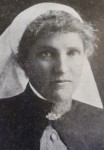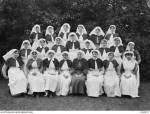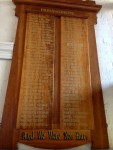ROSS, Clara Louisa
Clara Louisa Ross
Clara Louisa Ross (1874–1952) served with the Australian Army Nursing Service in Egypt, France and England. Well qualified and highly experienced when she enlisted in 1914, she was promoted from sister to head sister and then matron, and decorated with the Royal Red Cross (1st Class) decoration and the Order of the British Empire (Military Division) in 1918 and 1919 respectively.
She was repatriated to Australia in 1919, but returned to England for further experience in the early 1920s. Back in Australia in 1924, she became matron of two major country hospitals in Victoria, first in Castlemaine and then Geelong. She was also active in various civilian and military nursing organisations in the 1930s.
Clara Ross is commemorated on the Honour Board at St Peter's Church, Eastern Hill, East Melbourne.
She died aged 78 in 1952.
+++
Before the War
Clara Louisa Ross (1874–1952) was the third of four children (2 sons, 2 daughters) born to Alexander Ross (1821–1893) and his wife Margaret Coleman (nee Ashenden) (1846–1926).
The death notice for Clara’s father noted that Alexander was a ‘colonist of 54 years’ (Argus, 10.10.1893, p1), which dates his arrival as 1839. He had been born in India, the eldest of the four sons of Major John Ross (1788–1838) and his wife Janet (Jessie) (nee Rose) (1802–1829). He and his brothers had been raised partly in Scotland by his mother’s family, including her father, the Rev. Dr Alexander Rose, minister of the High Kirk, Inverness (Ruth Gooch, Frontier French Island [2006], p44).
The subsequent prominence of his youngest brother William as a pastoralist and parliamentarian in Victoria means some details of Alexander’s early life are known. William and Alexander arrived in New South Wales in the 1830s. William ran Meilman Station at Euston on the Murray river, with which Alexander was also associated for a time (Sydney Morning Herald, 28.8.1860, p5). In the 1860s, Alexander was also involved in Quiamong Station, a cattle run near Deniliquin.
In 1869, Alexander married Margaret Coleman Ashenden, daughter of Benjamin Colvill Ashenden, a builder living in Daylesford. The Ashendens had come to the colony in 1857. Ashenden, initially a carpenter, had turned his hand to the invention and presumably building of agricultural implements. In 1873–74 he promoted his combined mechanical reaper and binder widely in newspapers around the Australian colonies. Agricultural implements may have brought Alexander – a purchaser – and Margaret – the seller’s daughter – together. Alexander was 48, Margaret was 23.
Ross had moved permanently to Victoria from New South Wales. He was successful in a ballot for land on Phillip Island in late1868 (Argus, 3.11.1868, p6), and purchased a town block in Rhyll. When nearby French Island was opened up for selection, he took up nearly 100 hectares. He built a substantial weatherboard house on his farm, expanded his holding, hired labour to undertake the work, and described himself as a ‘French Island squatter’. He had pigs and grew oats, wheat, potatoes and chicory (the latter unsuccessfully). He was still active in French Island interests in the early 1880s (Gooch, Frontier French Island, pp44-46).
The couple’s four children were born in the 1870s on French or Phillip Island: John Alexander Horatio in 1870, Alice Margaret in 1872, Clara Louisa in 1874 and Arthur William (known as Will) in 1876.
In 1880, Ross placed his farm ‘Tankerton’ on the market (Argus, 26.10.1880, p2), and relocated to Melbourne. At the time of his death in 1893, his designation in the Malvern rate assessment book was ‘Gentleman’.
In the period between their father’s death and the outbreak of war in 1914, the children of Alexander and Margaret established their adult lives. Alice married Donald Henderson, a farmer, in 1910. John was licensee of the Kew Hotel, High St, Kew, where his wife, mother and brother also lived (Australian Electoral Roll, 1909, 1913).
Clara for her part had taken up nursing. She completed the Melbourne Hospital certificate in 1902, and the Royal Victorian Trained Nurses Association (RVTNA) requirements in 1904. She followed these qualifications with certificates from the Queen’s Memorial Infectious Diseases Hospital at Fairfield and the Women’s Hospital in Carlton. She was appointed a sister at the Melbourne Hospital and remained on staff for six years. In addition she had experience as a night sister, in private hospitals and in private nursing. In 1908, she completed the matrons’ certificate auspiced by the RVTNA (Bendigo Advertiser, 16.1.1908, p 3).
In 1909, Clara Ross was appointed matron of the hospital in Ararat, 200 kms from Melbourne (Horsham Times, 25.3.1909). She held the post for almost five years until she resigned suddenly in early 1914 (Ararat Chronicle, 11.2.1914, p2). There were no reports in the local press of farewells. She may have returned to Melbourne to nurse her brother’s wife who died several months later (Argus, 28.8.1914, p1).
War had just broken out. Within a short time, Clara Ross had enlisted in the Australian Army Nursing Service. She gave her address as Miss Garlick’s Hospital in Flinders Lane, Melbourne, and may well then have attended St Peter’s Church Eastern Hill in nearby East Melbourne where there was a strong network of nurses and the Guild of St Barnabas for their social and spiritual lives.
War Service
Ross was a highly qualified and experienced nursing sister and 40 years old when she enlisted in late 1914. Patriotism and professional commitment were presumably key factors in the decision, but two individuals may also have played a significant part. The main recruiter of Victorian nurses to accompany the First AIF in November 1914 was Jane Bell. Bell, lady superintendent of the Melbourne Hospital from 1910, may well have deliberately sought Melbourne Hospital experienced staff such as Ross for 1 Australian General Hospital.
A second influence may have been Ross’s younger brother Arthur (Will), who enlisted soon after the outbreak of war in August. Arthur, a public servant, had served with the 5th Victorian Mounted Rifles in the South African War in 1901–02. Days before enlisting, he married Estelle, daughter of a distinguished Victorian soldier, Lieutenant Colonel Douglas Henry (Table Talk, 24.9.1914). He enlisted with the rank of staff sergeant in 1 Australian Division headquarters, and was to serve much of the war in Egypt, rising to Deputy Assistant Director of the Army Postal Service. (His camera and photo albums are in the Australian War Memorial.) He sailed in October 1914, she a few weeks later.
Sister Clara Ross, aged 40, left Melbourne on the 'Kyarra' with 160 other nurses and medical officers who made up the 1 and 2 Australian General Hospitals. After a fine farewell from the Royal Victorian Trained Nurses Association (Punch, 26.11.1914), the group left on 5 December 1914. There were other nurses from East Melbourne in the group, including at least one other PLC girl Alice Ross King. The nurses of the 1AGH were led by Jane Bell, Principal Matron who as lady superintendent of the Melbourne Hospital had signed Edith Cameron's AANS application. The seven week voyage with its seasickness, lectures and deckgames was recorded in the diary of Staff Nurse Elsie Cook (Peter Rees, The Other ANZACs: Nurses at War, 1914-1918, pp. 7-11, 15).
'Kyarra' reached Egypt on 20 January 1915. 1AGH was set up in the Heliopolis Palace Hotel, a four story luxury facility in the Cairo suburb of Abbassia. Ross was attached to 1AGH throughout most of its duty in Egypt, a time of near continuous high drama. The deluge of casualties evacuated from the Gallipoli peninsula placed enormous physical and emotional demands on the nursing staff which was expanded with reinforcements as the number of beds expanded (see Rees, The Other ANZACS, pp. 44-45, 48-49). In addition, there was the battle for authority between Principal Matron Bell and 1AGH Commanding Officer Colonel Ramsay Smith that led to the recall of both to Australia in July 1915, a formal inquiry and termination of their appointments (Jan Bassett,Guns and Brooches: Australian Army Nursing from the Boer War to the Gulf War, 1992, pp. 34-39).
By early 1916, after the Australian troops had left the Dardanelles, 1AGH prepared to pack up and relocate to Rouen in northern France, as personnel, equipment and battle fronts moved to the Western Front. There were still troops in Egypt, however, requiring hospital facilities (provided by 14 Australian General Hospital). Ross was sent to be matron at the Ras el Tin convalescent hospital in Alexandria. Equipped with 500 beds, Ras el Tin was a converted school, comfortable and ideal for patients needing treatment in the sea, ‘an admirable seaside convalescent hospital’ (J W Bennett and Percival E Dean, Australian Army Medical Corps in Egypt, www.gutenberg.org [E-book #41911]). Her patients were recuperating sufficiently either to return to their unit, and there would have been considerable churn as recovered troops left and new patients arrived.
In July 1916, Ross left Ras el Tin Hospital and after leave in England rejoined her unit, 1AGH, by then set up on the racecourse in Rouen. In her six months at 1AGH (31 July 1916–31 January 1917), the hospital expanded several times from its original 200 beds. Most patients in Sister Ross’s wards were wounded (e.g. by gun shot, shrapnel or gas) rather than sick, and the majority were evacuated to England after several days. The nurses’ work included the multitude of tasks associated with an unceasing round of admissions, treatments and preparation for transport to England, convalescent camps, other hospitals or return to their unit. In her time there, the average length of stay of patients fell from seven days to three days, indicating the degree of churn (1AGH, War Diary).
Ross was at 1AGH during the early months of the notorious ‘Somme winter’ of 1916–17. As autumn then winter set in, nurses succumbed to respiratory illnesses. Late in November, the Matron-in-Chief noted the steadily increasing numbers of sick nursing staff. Ross seems to have escaped serious illness or hospitalization but at the end of January 1917 she was transferred to 3AGH, then located in Brighton in England preparing to move to France.
Ross spent several months in Brighton and then returned to France, this time Abbeville, with 3AGH. Led by Matron Grace Wilson, 3AGH had 1500 beds, medical officers and 90 sisters. They were soon inundated with sick and wounded troops direct from the front, usually several hundred at a time.
Ross were there for nearly four months before being transferred in July 1917 back to England, as Temporary Matron of 2 Australian Auxiliary Hospital at Southall near London. She spent the remainder of the war in England, moving between the three Australian General Hospitals at Southall (2AAH), Harefield (1AAH) and Dartford (3AAH). In November 1917, she was appointed matron of 1AAH, where she remained for the duration of the war.
Australia’s three auxiliary hospitals specialized in treating particular injuries and illnesses. Southall, for example, patients were single and multiple amputees. Many of Ross’s patients (numbering 1400 when the hospital was full) were afflicted with ‘nerves’ and shell shock. Much effort was put into the medical treatment of patients, comforts, entertainment and outings, the latter organised by a dedicated group of volunteers made up notable Australian women living in London. It was a point of pride that the majority of the 50 000 the hospital treated between 1915 and early 1919 returned to their units for further action.
The most demanding time during Clara Ross’s period as matron was the outbreak of influenza and pneumonia in late 1918. Those illnesses caused more deaths than at any other period in the hospital’s history (1AAH, War Diary [AWM])
The war ended on 11 November. 1AAH was effectively empty of patients by the end of January 1919.
She was decorated with the Royal Red Cross (1st Class) for her work as matron.
After the War
Ross remained in England for some months after the armistice. As she had not returned to Australia since 1914, she was eligible for ‘non military employment’ (NME) with pay, living allowance and fees. She used it for a course at the well-known and influential National Training School of Cookery in London. It must have been an enjoyable time: her brother Will was using his NME entitlement to study singing at the prestigious Wigmore Hall Studios in London at the same time (Arthur William Ross, Service Record, NAA). In addition, she was made a member of the Order of the British Empire (Military Division) in mid 1919, in addition to the Royal Red Cross (1st Class) presented to her by King George V in 1918.
Clara Ross returned to Australia in October 1919 with 1300 repatriated troops on the steamer ‘Anchises’. Her medical examination showed she was ‘run down [and] anemic’ and in need of major dental treatment (Ross, Service Record). A month later she had made good progress.
She was discharged from the Australian Army Nursing Service on 11 January 1920.
After a year or so in Melbourne, Ross returned to London to further her professional expertise. She nursed with an Australian doctor who had an interest in the treatment of paralysis, then returned to Melbourne in a third class berth in late 1924 on the ‘Jervis Bay’ (findmypast passenger lists; Table Talk, 2.4.1925, p37; Kai Tiaki, the journal of the nurses of New Zealand XVIII (1) Jan 1925, p46).
In 1925, Ross was the successful applicant for the position of matron of Castlemaine Hospital, north of Melbourne. Two years later she was appointed matron of Kitchener Memorial Hospital in Geelong, a relatively new institution built largely with funds raised in the local community (John E. McClelland, From infirmary to hospital: Geelong and District Hospital (Kitchener Memorial) 1924 to 1966 (1996). Selected from a field of 29, she spent the rest of her working life in the position, resigning only in 1939 at the age of 65. She was perhaps the last of the hospital’s traditional matrons, intensely hard working (not least through the Depression years) but ‘ready ... to live with an autocratic committee and be of an inferior status’ (McClelland, p100).
In addition to her hospital responsibilities, Matron Ross found time to be actively involved in military and civilian nurses’ organizations in the state, including the Returned Nurses Association, fund-raising for the College of Nursing, the Victorian Nurses Board, and the Matrons’ Conferences.
Clara Ross was widely lauded wherever she went. Applauding the Royal Red Cross decoration and her local connections, the Ararat Advertiser believed her to be ‘one of the most capable nurses in the army service’ (Ararat Advertiser, 10.9.1918, p2). In Castlemaine, the local returned servicemen regarded her as a ‘princess of matrons’ (Table Talk, 3.3.1927, p52). In an article on Victoria’s Great War nurses, Melbourne’s Age described the Kitchener Memorial Hospital as being under her ‘generalship’ (Age, 11.11.1937, p3)
Clara Louisa Ross died after a short illness on 20 December 1952, aged 78. She was privately cremated. Her two siblings and nieces survived her (Age, 23.12.1952, p8).
Clara Ross is commemorated on the Honour Board at St Peter's Church, Eastern Hill, East Melbourne.
Janet Scarfe
Adjunct Research Associate, Monash
18 September 2016



